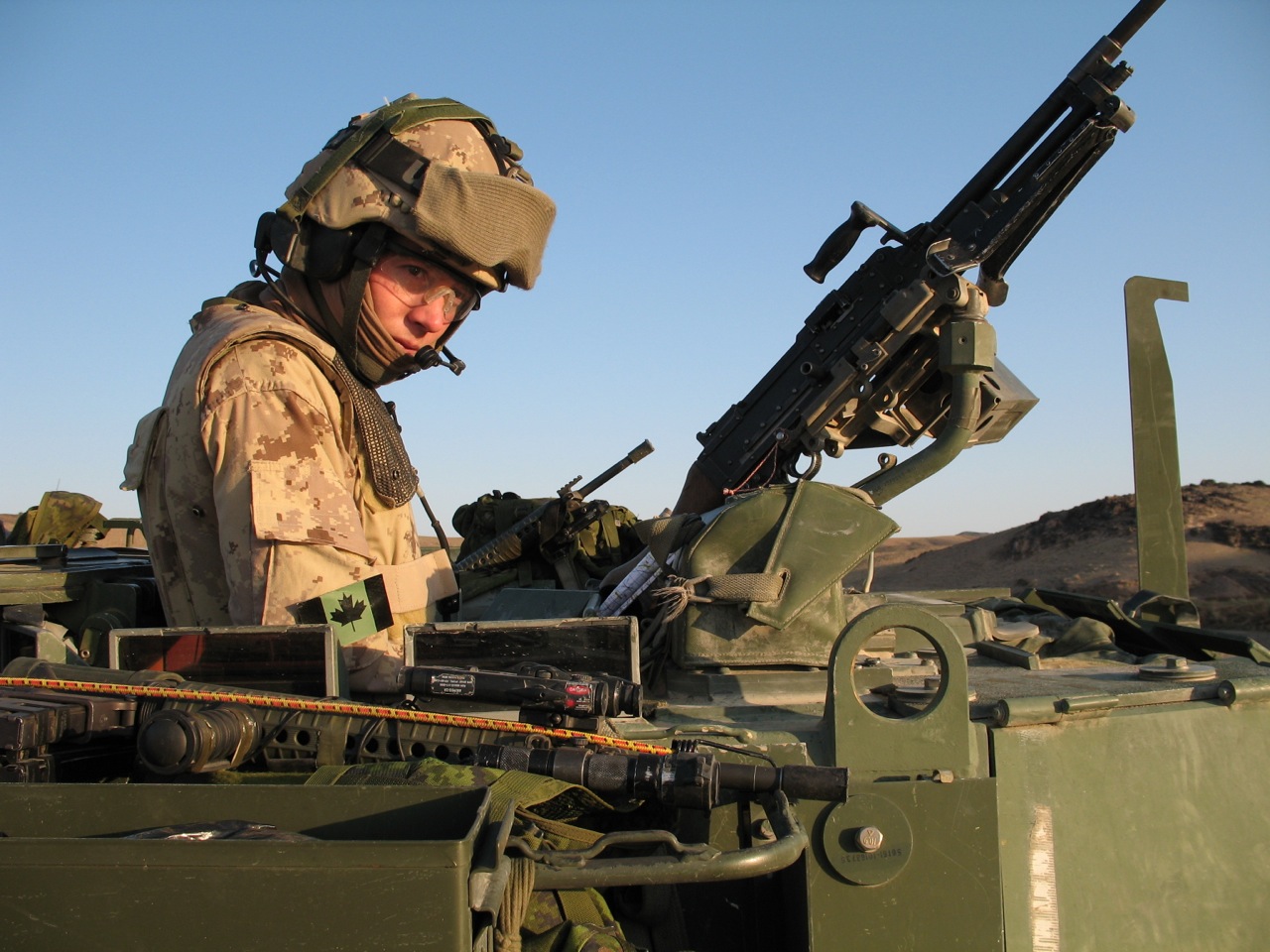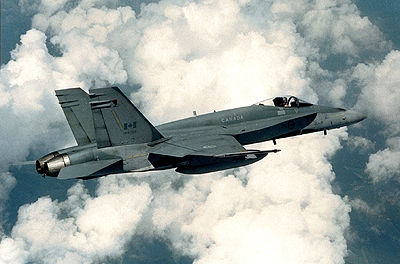The Canadian Armed Forces (CAF) is the military arm of the federal government. Its role is to defend Canada’s security, interests and values and to contribute to international peace and security. There are 68,000 Regular Force and 27,000 Reserve Force members in the CAF, which includes the Royal Canadian Navy, the Canadian Army and the Royal Canadian Air Force. Members of these three services can also be assigned to different commands, including Canadian Joint Operations Command (CJOC), Canadian Special Operations Forces Command (CANSOFCOM) and the North American Aerospace Defense Command (NORAD). The CAF is supported by 24,000 DND civilians, who are not part of the CAF.

Structure and Organization
The Canadian Armed Forces (CAF), like the Department of National Defence (DND), reports to the Minister of National Defence. They are, however, separate organizations. The CAF is the military arm of Canada’s defence team, while DND supports the CAF and is responsible for policy, resources, coordination with other departments and international defence relations. The chief of the defence staff (CDS) is the head of the CAF and is responsible for its command, control and administration, as well as military plans.
National Defence Headquarters (NDHQ)
National Defence Headquarters (NDHQ) commands and administers both DND and the CAF. Certain senior positions in NDHQ report to both the CDS and the deputy minister of national defence, who heads DND. This includes the vice chief of the defence staff (VCDS), a senior military officer who provides strategic direction and monitors progress in achieving key priorities. The VCDS is also responsible for security, safety, cadets, military police and defence liaison.
The Strategic Joint Staff (SJS) is also part of NDHQ and provides military analysis and advice to the CDS. Military Personnel Command (MPC) and the Canadian Forces Intelligence Command (CFINTCOM) are also located at NDHQ and report directly to the CDS. MPC provides guidance and direction to the CAF on the management of military personnel. Its key responsibilities are recruiting, training, education, pay, benefits, pensions, health services, chaplain services, honours, recognition, history and heritage. CFINTCOM provides intelligence products and services to the CAF and other agencies.

An illustration of the Department of National Defence’s high-level reporting structure from the Minister of National Defence to senior levels of the organization.
(courtesy Department of National Defence/Government of Canada)
Royal Canadian Navy (RCN)
The Royal Canadian Navy (RCN) is the maritime component of the CAF. Its mission is to generate combat-capable, multipurpose naval forces to support Canadian participation in security operations worldwide. It consists of 8,300 Regular Force sailors and 3,600 in the Naval Reserve, supported by 3,800 civilians. The commander of the RCN is a vice-admiral who is based at NDHQ and is supported by a naval staff.
The main components of the RCN are Maritime Forces Atlantic (MARLANT), Maritime Forces Pacific (MARPAC) and the Naval Reserve (NAVRES). MARLANT is based in Halifax, Nova Scotia, and is the home base of the Canadian Fleet Atlantic. MARPAC is based in Esquimalt, British Columbia, and is the home base of the Canadian Fleet Pacific.
Each fleet consists of multirole patrol frigates, maritime coastal defence vessels and long-range patrol submarines. A converted civilian replenishment ship with a mixed naval/civilian crew entered service in January 2018 on a five-year lease, while two dedicated naval ships are being built. The navy also accepted the first of six Arctic and offshore patrol ships in July 2020.
NAVRES consists of 24 divisions from coast to coast, with a headquarters in Quebec City. Its main responsibility is to operate the maritime coastal defence vessels based on each coast.

The Canadian Halifax-class frigate HMCS Ottawa departs Naval Station Pearl Harbor, Hawaii, 8 July 2008, to participate in Rim of the Pacific (RIMPAC) 2008. RIMPAC is biannual exercise hosted by U.S. Pacific Fleet that brings together military
forces from Australia, Canada, Chile, Peru, Japan, the Netherlands, Singapore, the United Kingdom and the Republic of Korea. (2008)
(photo by MC1 Michael Moriatis, courtesy US Navy/Wikimedia CC)
Canadian Army (CA)
The Canadian Army (CA) is the land component of the CAF. Its mission is to generate combat-effective, multipurpose land forces to meet Canada’s defence objectives. It is the largest component of the CAF and consists of 23,000 Regular Force personnel and 19,000 Reserve Force personnel, supported by 3,300 civilians. The army includes many different trades such as infantry, armour, artillery, combat engineer and signals. The commander of the Canadian Army is a lieutenant-general who is based at NDHQ and is supported by an army staff.
The army includes four geographically based divisions: 2nd Division in Quebec, 3rd Division in Western Canada, 4th Division in Ontario and 5th Division in Atlantic Canada. (1st Canadian Division was once commanded by the army but in 2015 became part of Canadian Joint Operations Command). Each division includes regular and reserve units. All except 5th Division include a mechanized brigade group.
A unique component of the CA Reserves is the Canadian Rangers. About 5,000 Canadian Rangers, many of whom are Indigenous, live in more than 200 remote, isolated and coastal communities. They provide the CA with experienced “eyes and ears on the ground” to support national security and public safety in these areas. The Canadian Rangers are divided into five Canadian Ranger Patrol Groups.
Royal Canadian Air Force (RCAF)
The RCAF is the air component of the CAF. Its mission is to defend and protect Canadian and North American airspace, in partnership with the United States. It includes a wide range of fighter, maritime aviation, tactical aviation, transport, search-and-rescue and training aircraft. The RCAF consists of 12,000 Regular Force personnel and 2,100 Reserve Force personnel, supported by 1,500 civilians. The commander of the RCAF is a lieutenant-general who is based at NDHQ and supported by an air force staff.
The major components of the RCAF are 1 Canadian Air Division (1 CAD) and 2 Canadian Air Division (2 CAD). The headquarters of both divisions are located in Winnipeg. 1 CAD commands the operational squadrons of the RCAF in 11 wings across Canada. The commander of 1 CAD is also the commander of the Canadian NORAD Region, which includes all Canadian airspace. 2 CAD is responsible to generate and train personnel for the RCAF. Its main components are three wings in Ontario, Manitoba and Saskatchewan.

CAF Commands
Members of the Canadian navy, army and air force, whether regular or reserve, can be assigned to other commands. This includes Canadian Joint Operations Command (CJOC), Canadian Special Operations Forces Command (CANSOFCOM) and North American Aerospace Defense Command (NORAD).
Canadian Joint Operations Command (CJOC)
Canadian Joint Operations Command (CJOC) plans and leads all CAF domestic and foreign missions, except for those conducted solely by NORAD or CANSOFCOM. CJOC is commanded by a vice-admiral/lieutenant-general who is assisted by a headquarters staff and is based in Ottawa.
CJOC includes 1st Canadian Division Headquarters, a joint, high-readiness headquarters that is based in Kingston, Ontario, but can move quickly to respond to crises in Canada and around the world. CJOC also includes six standing regional Joint Task Force Headquarters based at navy headquarters in Halifax and Esquimalt and army divisional headquarters in Montreal, Toronto and Edmonton, plus Joint Task Force North in Yellowknife; and CAF deployed task forces. Most of the personnel and other resources deployed on operations are not part of CJOC; they are assigned by the navy, army, air force and other organizations when required.
Canadian Special Operations Forces Command (CANSOFCOM)
The main mission of the Canadian Special Operations Forces Command (CANSOFCOM) is counterterrorism, although it can conduct a wide range of special operations on short notice in Canada and abroad. It is commanded by a rear-admiral/major-general and consists of Joint Task Force 2, Canadian Joint Incident Response Unit, Canadian Special Operations Regiment, 427 Special Operations Aviation Squadron and Canadian Special Operations Training Centre. CANSOFCOM recruits directly from the Regular and Reserve Forces.
Joint Task Force 2 (JTF 2) was established in 1993 to take over the responsibility for domestic hostage rescue and counterterrorism from the RCMP. After the attacks of 9/11, JTF 2 was committed to international special forces operations in Afghanistan, the first time it was used in a significant combat role outside of Canada. JTF 2 personnel have also been deployed to Bosnia and Haiti. The Canadian Joint Incident Response Unit (CJIRU) was created in the aftermath of 9/11 to provide a rapid chemical, biological, radiological and nuclear response for special operations missions. Within Canada, CJIRU responds to such threats with the RCMP and the Public Health Agency of Canada.
North American Aerospace Defense Command (NORAD)
NORAD is a binational United States-Canada organization responsible for aerospace warning, aerospace control and maritime warning for North America. NORAD consists of three regions: Alaskan, Canadian and Continental United States. The Canadian NORAD Region Headquarters is colocated with 1 CAD Headquarters in Winnipeg. CF-18 Hornet fighter aircraft, some on continuous alert, are assigned to NORAD. The Canadian NORAD Region also operates and maintains the Canadian portion of the North Warning System, a series of long- and short-range radars stretching along the Arctic coast. The NORAD commander, an American admiral/general, reports to the CDS and the US secretary of defence. NORAD’s deputy commander is always a Canadian lieutenant-general.

 Share on Facebook
Share on Facebook Share on X
Share on X Share by Email
Share by Email Share on Google Classroom
Share on Google Classroom





